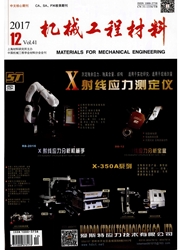

 中文摘要:
中文摘要:
采用双辉等离子渗金属技术在0Cr18Ni9Ti奥氏体不锈钢表面制备渗锆合金层,然后将其分别置于在0.5mol·L^-1 HCl溶液、3.5%NaCl溶液、0.5mol·L^-1 NaOH溶液中进行电化学腐蚀试验,另在静态空气中进行了1 000~1 150℃的高温氧化试验,研究了渗锆合金层的耐腐蚀性能及抗高温氧化性能,并与不锈钢基体进行了对比。结果表明:在三种溶液中,不锈钢基体的相对腐蚀速率分别为渗锆合金层的24.43倍、2.44倍、1.90倍,不锈钢基体表面发生了较为严重的腐蚀,而渗锆合金层只出现了局部腐蚀坑,这是因为在腐蚀过程中其表面形成了一层致密的ZrO2钝化膜;不锈钢基体和渗锆合金层的氧化质量增加曲线都基本遵从抛物线规律;在1 150℃氧化20h后,不锈钢基体表面氧化严重,而渗锆合金层的表面形貌较好,存在少量孔洞,组织相对致密。
 英文摘要:
英文摘要:
Zr-alloyed layer was prepared on 0Crl8Ni9Ti austenitic stainless steel surface by double-glow plasma surface alloying technology, and then electrochemical corrosion tests were performed in 0.5 mol ·L^-1 HC1 solution, 3.5 %NaCl solution and 0.5 mol ·L^-1 NaOH solution, respectively. Besides, high temperature oxidation experiments of the Zr-alloyed layer were carried out in static air at 1 000-1 150 ℃. The corrosion resistance and high temperature oxidation resistance of the Zr-alloyed layer were studied, and compared with those of the stainless steel substrate. The results show that, in the three types of solutions, the relative corrosion rate of the stainless steel substrate was respectively 24. 43, 2.44, 1.90 times that of Zr-alloyed layer, the surface of the stainless steel substrate exhibited serious corrosion, but the Zr-alloyed layer only exhibited some localized corrosion pits, due to the formation of a dense ZrO2 passivation film on Zr-alloyed layer surface during corossion. The oxidation mass gain curves of the stainless steel substrate and the Zr-alloyed layer followed mainly the parabolic law. After corrosion at 1 150 ℃ for 20 h, the surface of the stainless steel exhibited severe oxidation, but the Zr-alloyed layer had a good surface morphology with less holes and the structure was very dense.
 同期刊论文项目
同期刊论文项目
 同项目期刊论文
同项目期刊论文
 Effect of Rare Earth on the Microstructure and Tribological Properties ofLaser Cladding Ni-Based Coa
Effect of Rare Earth on the Microstructure and Tribological Properties ofLaser Cladding Ni-Based Coa Microstructure and wear resistance of Cu-W alloy contact material prepared by laser shock processing
Microstructure and wear resistance of Cu-W alloy contact material prepared by laser shock processing Microstructure and corrosion resistance of laser cladding rare earth CeO2 + Ni60 alloy coatings on 6
Microstructure and corrosion resistance of laser cladding rare earth CeO2 + Ni60 alloy coatings on 6 Effect of La2O3 on Microstructure and Corrosion Resistance of Laser Cladding Ni60 Alloys Coatings on
Effect of La2O3 on Microstructure and Corrosion Resistance of Laser Cladding Ni60 Alloys Coatings on Microstructure and Wear Resistance of CeO2+Ni60A Composite Coating on Aluminum Alloys by Laser Cladd
Microstructure and Wear Resistance of CeO2+Ni60A Composite Coating on Aluminum Alloys by Laser Cladd Microstructure and wear resistanced of deposited rare earth CeO2 + Ni60 alloys coatings on 6061 Al a
Microstructure and wear resistanced of deposited rare earth CeO2 + Ni60 alloys coatings on 6061 Al a Corrosion resistance of Zr-alloyed layer on austenite stainless steel by double glow plasma techniqu
Corrosion resistance of Zr-alloyed layer on austenite stainless steel by double glow plasma techniqu High-temperature oxidation behavior of (Ti, Cr)N coating deposited on 4Cr13 stainless steel by multi
High-temperature oxidation behavior of (Ti, Cr)N coating deposited on 4Cr13 stainless steel by multi 期刊信息
期刊信息
